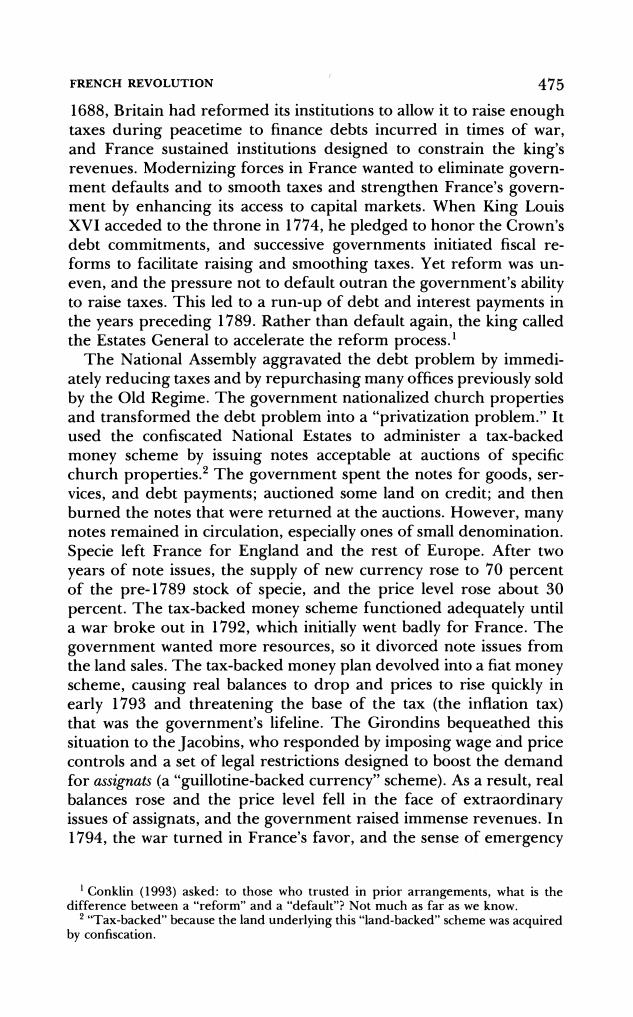正在加载图片...

FRENCH REVOLUTION 475 1688,Britain had reformed its institutions to allow it to raise enough taxes during peacetime to finance debts incurred in times of war, and France sustained institutions designed to constrain the king's revenues.Modernizing forces in France wanted to eliminate govern- ment defaults and to smooth taxes and strengthen France's govern- ment by enhancing its access to capital markets.When King Louis XVI acceded to the throne in 1774,he pledged to honor the Crown's debt commitments,and successive governments initiated fiscal re- forms to facilitate raising and smoothing taxes.Yet reform was un- even,and the pressure not to default outran the government's ability to raise taxes.This led to a run-up of debt and interest payments in the years preceding 1789.Rather than default again,the king called the Estates General to accelerate the reform process.I The National Assembly aggravated the debt problem by immedi- ately reducing taxes and by repurchasing many offices previously sold by the Old Regime.The government nationalized church properties and transformed the debt problem into a "privatization problem."It used the confiscated National Estates to administer a tax-backed money scheme by issuing notes acceptable at auctions of specific church properties.2 The government spent the notes for goods,ser- vices,and debt payments;auctioned some land on credit;and then burned the notes that were returned at the auctions.However,many notes remained in circulation,especially ones of small denomination. Specie left France for England and the rest of Europe.After two years of note issues,the supply of new currency rose to 70 percent of the pre-1789 stock of specie,and the price level rose about 30 percent.The tax-backed money scheme functioned adequately until a war broke out in 1792,which initially went badly for France.The government wanted more resources,so it divorced note issues from the land sales.The tax-backed money plan devolved into a fiat money scheme,causing real balances to drop and prices to rise quickly in early 1793 and threatening the base of the tax (the inflation tax) that was the government's lifeline.The Girondins bequeathed this situation to the Jacobins,who responded by imposing wage and price controls and a set of legal restrictions designed to boost the demand for assignats (a "guillotine-backed currency"scheme).As a result,real balances rose and the price level fell in the face of extraordinary issues of assignats,and the government raised immense revenues.In 1794,the war turned in France's favor,and the sense of emergency I Conklin (1993)asked:to those who trusted in prior arrangements,what is the difference between a "reform"and a"default"?Not much as far as we know. 2"Tax-backed"because the land underlying this "land-backed"scheme was acquired by confiscation.FRENCH REVOLUTION 475 1688, Britain had reformed its institutions to allow it to raise enough taxes during peacetime to finance debts incurred in times of war, and France sustained institutions designed to constrain the king's revenues. Modernizing forces in France wanted to eliminate government defaults and to smooth taxes and strengthen France's government by enhancing its access to capital markets. When King Louis XVI acceded to the throne in 1774, he pledged to honor the Crown's debt commitments, and successive governments initiated fiscal reforms to facilitate raising and smoothing taxes. Yet reform was uneven, and the pressure not to default outran the government's ability to raise taxes. This led to a run-up of debt and interest payments in the years preceding 1789. Rather than default again, the king called the Estates General to accelerate the reform process.1 The National Assembly aggravated the debt problem by immediately reducing taxes and by repurchasing many offices previously sold by the Old Regime. The government nationalized church properties and transformed the debt problem into a "privatization problem." It used the confiscated National Estates to administer a tax-backed money scheme by issuing notes acceptable at auctions of specific church properties.2 The government spent the notes for goods, services, and debt payments; auctioned some land on credit; and then burned the notes that were returned at the auctions. However, many notes remained in circulation, especially ones of small denomination. Specie left France for England and the rest of Europe. After two years of note issues, the supply of new currency rose to 70 percent of the pre-1789 stock of specie, and the price level rose about 30 percent. The tax-backed money scheme functioned adequately until a war broke out in 1792, which initially went badly for France. The government wanted more resources, so it divorced note issues from the land sales. The tax-backed money plan devolved into a fiat money scheme, causing real balances to drop and prices to rise quickly in early 1793 and threatening the base of the tax (the inflation tax) that was the government's lifeline. The Girondins bequeathed this situation to the Jacobins, who responded by imposing wage and price controls and a set of legal restrictions designed to boost the demand for assignats (a "guillotine-backed currency" scheme). As a result, real balances rose and the price level fell in the face of extraordinary issues of assignats, and the government raised immense revenues. In 1794, the war turned in France's favor, and the sense of emergency I Conklin (1993) asked: to those who trusted in prior arrangements, what is the difference between a "reform" and a "default"? Not much as far as we know. 2 "Tax-backed" because the land underlying this "land-backed" scheme was acquired by confiscation